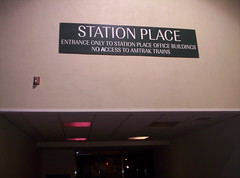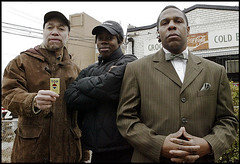Eight years later, enclave development is still not a "solution" for Anacostia
This week's City Paper has a piece, "Rescue Mission: The Coast Guard Hasn't Done Much for Ward 8." I guess it's an excuse for revisiting blog entries dating back 8-9 years, which predicted that the Coast Guard likely wouldn't contribute very much to Anacostia's revitalization.
-- "Enclave development won't "save" Anacostia"
It's always nice to be proved right, but that isn't really the point. I'd rather we do better from the outset.
The reason that such developments don't contribute much is that office workers don't spend much locally, they don't get out much. In locations with high security requirements, it's worse because it's inconvenient and time consuming to leave the campus during the day, making spillover improvement difficult.
But I guess I would have to revise the argument of the blog entry, reprinted below, somewhat. I argued that Station Place, next to Union Station, is a good example of enclave development not contributing to the surrounding neighborhood.
For the most part that's been true, But because of the how the site is located within a larger, connected area, over a 10+ period of time its contribution is more evident.
It filled an empty lot, making it easier and more logical to build beyond the gap. It has encouraged the creation of housing across the street--not quite yet ready to open--and it probably contributes to the viability of moving forward with Burnham Place, the challenging project of decking over a goodly section of the Union Station railyard, and has likely been a small contributor to Amtrak's Union Station expansion planning as well.
These are all big projects, which in turn leverage different revitalization energies along H Street NE, but at the same time, leverage existing well placed neighborhoods and anchors, in particular Union Station.
As importantly, the site wasn't disconnected from the street and block network of the city. That's why, even though the building complex is inwardly focused and there is limited contribution of workers there to local business (although there is some patronage of a coffee shop and restaurant at the intersection of F and 2nd Streets NE), the development of the site was able to be leveraged beyond it's impact on local retail
By contrast, St. Elizabeths West and East Campuses are disconnected from the neighborhoods around them. They are enclaves. For these "campuses" to be assets that promote revitalization of the neighborhoods surrounding them, they have to connect to the city outside of the walls of the campuses.
To be honest, I think I am a decent enough planner, and even so it is challenging to come up with a strategy to do this. But it can be done.
But it's very expensive. And it wouldn't be an overnight success. I would focus on building long term anchors, leveraging public investment in civic institutions, and knitting together the enclaves with the community.
1. I would move the University of the District of Columbia to the West Campus, and simultaneously encourage the development of an "open air" research park/"Innovation District" around it.
The move would be expensive and in years past a similar proposal by then Mayor Williams was criticized as moving the predominately black school out of an otherwise "white" area. But selling the current campus would generate some money too.
2. I'd let the Federal Government back out of its plan to develop the East Campus, other than the Coast Guard, and I'd expand the research park stuff there as well.
As long as Republicans control the House of Representatives, the federal government is contracting, Long term, expecting Congress to sign off on expansion and investment in buildings located in DC is a losing proposition. So for DC to get control of this site and move forward on its own makes more sense.
3. I'd consider adding a Metrorail station between Anacostia station and Congress Heights station, not necessarily because of the distance between the stations, but because the topography up Martin Luther King Jr. Avenue is extremely challenging.
4. I think that Mayor Gray's proposal to move United Medical Center to a location adjacent to the Congress Heights station is worth pursuing. But I would have the facility be developed as an anchor for a broadened urban community health system.
Maybe it could involve Howard University, and moving their medical school to the campus.
But in any case, it should have community supporting facilities comparable to what St. Anthony's Hospital is doing in Chicago ("Chicago safety-net hospitals face uncertain future amid changes to health care system: Area has 20 safety-net hospitals, which are a stop-gap medical system for the poor," Chicago Tribune).
Such programming could complement programs at The Town Hall Education, Arts, and Recreation Center--although probably because the locations are so close, maybe that isn't a good idea...
5. I would tie together the planning for the 11th Street Bridge Park with integrated planning for Poplar Point as I have discussed previously ("11th Street Bridge design competition finalists"). For that, I also recommended the creation of an international water-focused environmental center and moving the Anacostia Community Museum to be next door.
6. Similarly, in the past, DC has done a piss poor job of leveraging civic investments in facilities to leverage other community improvement. The rebuilding of the Anacostia Library in a disconnected location on Good Hope Road SE is a perfect example of this. I would instead invest in a multipurpose library and cultural center and government building, at the Anacostia Metro Station.
See "Public buildings as vehicles for community improvement (continued)" about a government facility in the Roxbury section of a Boston as an example of what I mean or this piece from the Guardian, "Work begins on Drumbrae's new library, day care centre, and youth cafe," about a library-community facility in the UK..
Arguably this would be duplicative if UDC moved to St. Elizabeths West. But in any case, this kind of leveraging of community-civic investment does not happen very much in DC, and it contributes to languishing improvements in neighborhoods in need of extra-normal assistance.
=== Enclave Development won't save Anacostia ===== from 2006
 Station Place, the office complex next to Union Station, is connected directly to Union Station but residents of the area cannot walk through the building to the other side. Heralded as economic development for H Street, employees in the building serve their retail needs in Union Station. The line at the Union Station Starbucks during the day is full of office workers not wearing coats--temporary migrants from the Station Place building.
Station Place, the office complex next to Union Station, is connected directly to Union Station but residents of the area cannot walk through the building to the other side. Heralded as economic development for H Street, employees in the building serve their retail needs in Union Station. The line at the Union Station Starbucks during the day is full of office workers not wearing coats--temporary migrants from the Station Place building.Saturday's Post had this article, "Coast Guard Move Seen as SE Boon," about the latest revitalization "solution" for Anacostia (East of the River), having the Coast Guard relocate to part of the St. Elizabeth's Campus. From the article:
"City officials say moving the Coast Guard headquarters from Buzzards Point in Southwest Washington to the St. Elizabeths site could serve as a catalyst for the transformation of communities east of the Anacostia River."How does putting a bunch of people in an enclave, disconnected from the area outside of the campus, aid revitalization? Revitalization is about connecting to and building up the area around and outside. (Remember that office workers support about 2 s.f. of retail and 5 s.f. of restaurant space.)
An enclave is an enclave, whether it is a copper mine in Chile or the Walter Reed Hospital Campus on Georgia Avenue (note that there is little substantive retail development adjacent to this site, despite the thousands of employees that work there).
In third world nations, "enclave development" is a form of "development" where an industry is built around extracting and exporting unprocessed natural resources such as ore or oil, with limited benefits to the local economy in terms of connections. In the urban revitalization sense, there are are no "mixed primary uses" (Jane Jacobs) or what Fred Kent of the Project for Public Spaces calls "layering" of complementary activities that build quality places.
 Spinoff entertainment from Shell Oil gas flares. Rumeukpe, Nigeria. Photo copyright by Friends of the Earth.
Spinoff entertainment from Shell Oil gas flares. Rumeukpe, Nigeria. Photo copyright by Friends of the Earth. The Coast Guard workers likely will live in the suburbs, and they won't patronize many city establishments or linger much after work. And they won't likely evince much interest in the goings on of the Greater Anacostia area in which they will work.
I have written about Anacostia in:
-- Office buildings won't "save" Anacostia
-- One more thing about Anacostia and office buildings
-- Arson as a(nother) redevelopment strategem.
It's ironic that discredited "third world" economic development strategies are heralded as revitalization boosters for minority neighborhoods in the U.S. Here's a paper I need to read about these kinds of issues: "Concepts in Social and Spatial Marginality."
A paper on India, "Development of Colonial Economy in Kerala," describes enclave development there:
These agro-processing industries which accounted for around 65% of the factory employment represented a sort of enclave development, with very little forward or backward linkages. The machinery, equipment, hardware, fuel, chemicals, etc were mostly imported and the output which required only elementary processing was almost entirely exported....All these industries, including coir, were export oriented and were dependent upon the vagaries of foreign market demand. The technology, productivity and labour process in all these industries were caught in a vicious circle of permanent stagnation. Colonial domination, the relative surplus population and the consequent availablity of cheap labour depressed the tendency of capital to constantly improve the technique of production and centralisation...Anacostia provides land for development processes directed elsewhere, "with very little forward or backward linkages." Some boon. (Also see "Office ghettos aren't quality economic development.")
Since the production process in these industries involved only elementary or primary processing, and owing to the resultant semi-finished product nature of exports from this region, its increase by itself could not be taken as an index of industrial progress. There was very little inter-dependence between these agro-processing industries. Owing to their low technological basis, there was very little scope for the development of [indigenous] engineering or metal industries.
 Photo: Kevin Clark, The Washington Post. Phil Pannell, executive director of Anacostia Coordinating Council, (L-R) LaTesha Johnson, ANC 8A04 and Anthony Muhammad, ANC 8A are bring issues against establishments in close proximity to schools selling drug paraphernalia.
Photo: Kevin Clark, The Washington Post. Phil Pannell, executive director of Anacostia Coordinating Council, (L-R) LaTesha Johnson, ANC 8A04 and Anthony Muhammad, ANC 8A are bring issues against establishments in close proximity to schools selling drug paraphernalia. --
Labels: neighborhood revitalization, transportation planning, urban revitalization



4 Comments:
Good points. Don't these things take on an air of inevitability at some point, though? A small house on the 1400 block of V st SE just sold for 310k. Larger houses in Historic Anacostia now selling for 375k plus. The bridge park can only help and seems like it could be an incredible piece of infrastructure.
Congress Heights is a much larger neighborhood, of course, with several distinct nodes (as you noted). The St. E's redevelopment spaces are huge (I used to go in some of the building while doing social work, they were beautiful). But it is a very large combined space and govt is contracting. Hence your call for innovation centers is on point.
well, my post is more about the silver bullet concept of revitalization. As you know wrt H St., it's a lot more complicated.
It's only been a year. Surely no one was expecting a lot of change in a single year.
The Coast Guard's impact will be felt in what eventually comes to St. E's east. Developer interest there is predicated on the Coast Guard's presence - and the vague possibility of additional DHS presence - on the west side. And plans are to open the east campus up to the community so that it is better integrated. But they've got to get basic infrastructure there first and that alone will take a few years.
I think visibly significant changes - the kind that people outside of the neighborhood notice - are at least a decade away. And I live in Congress Heights, and I'm fine with that. It's a fine neighborhood now, and I am confident things will only get better.
you make a good point about the time, and time is a key element in revitalization. But I still stand by the argument in general. It's very difficult for enclaves to have spillover development that benefits the area outside of the enclave.
Post a Comment
<< Home